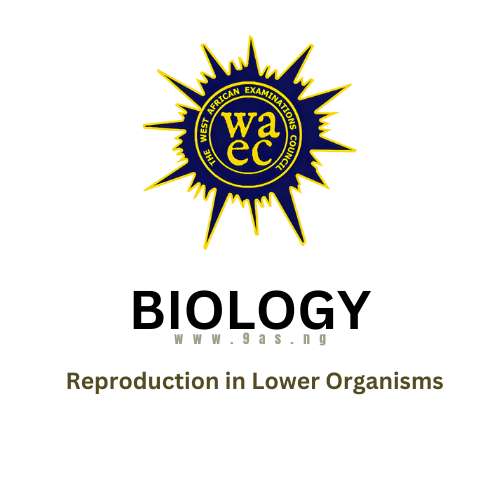Introduction:
Reproduction in lower organisms encompasses various methods by which simple life forms propagate. These methods include both asexual and sexual reproduction, each with distinct processes and significance. Understanding these reproductive strategies is crucial for students preparing for the WAEC Biology examination.
Key Concepts:
1. Asexual Reproduction Methods:
- Binary Fission: A common method in unicellular organisms like Amoeba and Paramecium, where the organism divides into two identical daughter cells.
- Budding: Observed in organisms such as Hydra, where a new individual develops from a protrusion on the parent and eventually detaches.Wikipedia
- Fragmentation: Seen in filamentous algae like Spirogyra, where the organism breaks into fragments, each capable of growing into a new individual.Wikipedia
2. Sexual Reproduction Methods:
- Conjugation: A form of sexual reproduction in some unicellular organisms like Paramecium and Spirogyra, involving the exchange of genetic material through direct contact.
- Gamete Formation: Involves the fusion of male and female gametes, as seen in organisms like Chlamydomonas.9as
3. Life Cycles and Dominant Stages:
- Alternation of Generations: Some lower plants, such as ferns, exhibit a life cycle alternating between haploid gametophyte and diploid sporophyte stages.
- Dominant Stages: In ferns, the sporophyte stage is dominant, while in mosses, the gametophyte stage prevails.
4. Adaptations for Reproduction:
- Spore Formation: Many fungi and algae produce spores that can withstand unfavorable conditions and germinate when conditions improve.
- Zygospore Formation: In Rhizopus, sexual reproduction leads to the formation of a zygospore, which can remain dormant until favorable conditions return.
5. Importance of Reproduction in Lower Organisms:
- Ensures survival and continuity of species.
- Allows for rapid population increase, especially through asexual means.
- Facilitates genetic variation and adaptability through sexual reproduction.
Study Tips:
- Understand Reproductive Methods: Differentiate between asexual and sexual reproduction, and know examples of organisms employing each method.
- Learn Life Cycles: Study the life cycles of lower organisms, noting the dominant stages and reproductive structures involved.
- Memorize Key Terms: Familiarize yourself with terms like binary fission, budding, conjugation, gametophyte, and sporophyte.
- Use Diagrams: Visual representations can aid in understanding complex processes like conjugation and alternation of generations.
- Review Past Questions: Use the questions below for study and practice.
Conclusion:
A thorough understanding of reproduction in lower organisms is essential for success in the WAEC Biology examination. By mastering the various reproductive strategies and their significance, students can appreciate the diversity and adaptability of life forms.
OBJECTIVES
1. During sexual reproduction in Paramecium, how many times does the zygote divide to produce eight nuclei?
A. 1. B. 2. C. 3.D. 4.
2. The dominant stage in the life cycle of a fern is the
A. antheridium: B. gametophyte. C. prothalfus. D. sporophyte.
3. Some animals return to water bodies to reproduce because
A. natural enemies destroy their eggs on land. B. water nourishes their embryos and their young ones. C. they are close to their ancestors and imitate them D. the temperature on land is not suitable for the development of their embryos.
4. Which of the following methods of reproduction is common to Paramecium and Amoeba?
A. Conjugation. B. Sexual reproduction. C. Binary fission. D. Budding.
5. Which of the following organisms is viviparous?
A. Tapeworm. B. Snail. C. Sheep. D. Grasshopper.
6. Which of the following organisms lacks a reproductive organ?
A. Chlamydomonas. B. Toad. C. Pride of barbados. D. Cockroach.
Use the information on the stages involved in conjugation to answer questions 7 and 8.
I.Transfer of one cell content into the adjacent cell II. Formation of a conjugation tube III. Secretion of thick. wall to form a zygospore IV. Formation of a protuberance V. Germination of a filament.
7. Which of the following organisms exhibits the stages listed above during conjugation?
A. Chlamydomonas. B. Euglena. C. Spirogyra. D. Volvox.
8. Which of the following arrangements is the correct sequence of the process?
A. A. II, I, IV, V and III. B. IV, II, I, III and V. C. IV, I, li, V and HI. D. V, II, III, IV and I.
9. When the zygote of an organism continues to grow, it produces new cells by
A. meiosis. B. crossing-over. C. gestation. D. mitosis.
10. How many conjugants are involved in sexual reproduction of paramecium?
A. 1. B. 2. C. 4. D. 8.
THEORY
- Explain briefly sexual reproduction in Rhizopus.


